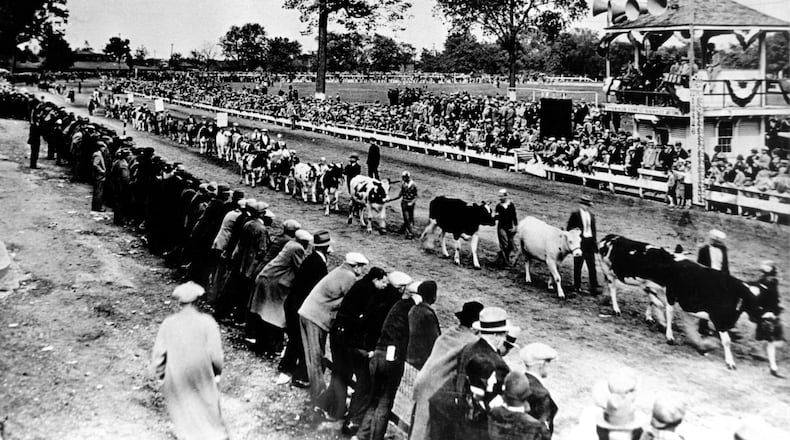Over the years, the fair expanded by adding displays of farm implements and agricultural machinery, many of them manufactured by Hamilton companies. A half-mile race track and wooden grandstand was constructed in 1876. Additional buildings, hog and cattle barns, and a large midway were built in subsequent years.
The wooden grandstand was replaced in 1913 with a steel and concrete facility that enabled the fair to offer large purses to attract the best harness racing teams from all parts of the country.
One hundred years ago the fair was being advertised in the Journal-News (Oct. 3, 1925) as “the biggest and best fair in southern Ohio.”
Over the four days and nights of the fair, patrons were given “an instructive and elevating exhibition of modern art, science and mechanical invention.”
Local firms had booths showcasing their goods including radios, electric washers and cleaners, stoves, pianos and Victrolas, vacuum sweepers, heat oil burners, water softeners and pumps, electric typewriters, and furniture. The machinery shed exhibited the latest farm implements such as cultivators, spreaders, silos, tractors, furnaces, plows and other work-saving equipment.
Under the grandstand was a display of automobiles of almost every make and model available from local businesses. There were so many vehicles and auto accessories being exhibited that an additional 200 foot run of tents for the automobiles was erected.
The midway attractions featured the usual side-shows, games of skill, a merry-go-round, a pony ride, other riding vehicles and attractions that were considered clean, amusing or instructive. One booth featured a man who had been involved in keeping Floyd Collins alive for days during his fatal entrapment in Kentucky’s Sand Cave during February 1925, a major national news event. Political parties and newspapers provided rest tents for visitors and the Journal News provided details of the ongoing World Series ball games.
Vendors sold candy, ice cream, popcorn, potato chips, waffles, hot dogs, cider, barbeque, canes, comeback balls, balloons, and other novelty items. Several local church groups offered home-cooked meals in tents.
Planned entertainment for each day included band concerts performed by two popular Hamilton musical groups, one on the fairgrounds and the other at the grandstand. Two novelty acts performed at the grandstand. One was “The Bucking Ford” a four-person automobile acrobat comedy act that featured a car that actually bucked like a horse or bronco bull.
The second was Marvelous Melville, the “unequaled sensational aerial gymnast” who performed a high wire trapeze act and twirled more than 75 revolutions per minute while he was high above the ground. There were fireworks displays during each evening.
The Rural Community Theatre program, originally begun in 1921, staged 10 one-act plays performed over three days by members of several township granges, farm bureaus, church groups and other rural organizations. Nearly all performances were sold out and the rural theatre program was one of the most popular attractions at the fair.
Harness racing was scheduled for all four days of the fair and originally offered purses totaling $4,300 (about $79,000 in 2025) but the Friday race card was canceled because the track was too muddy due to heavy rain.
Cash prizes were awarded to entries judged to be the best horses, cattle, sheep, swine, poultry, farm products, and dairy and pantry items and domestic art. In the farm products competition, the top two entries in categories such as potatoes, carrots, beans, apples, pears, pumpkins and other varieties of produce each received a $1.50 for first place or 75¢ for second place.
Neal Nixon, a farmer from Lebanon, won 23 first or second place awards for his potatoes, sweet potatoes, carrots, beans, squash, and cabbages. Nixon’s winning crops earned him a total of $27.50 ($505.00 in 2025). In the Dairy and Pantry competition, more than 125 first or second prize awards were made in more than 50 categories of fruit jellies, preserves, jams, cakes, cookies and breads.
Members of the Fairfield, Poasttown, Monroe, Hanover, Collinsville, Union, and Elk Creek granges each created exhibits and displays showing the garden products, fruits, vegetables, dairy and pantry products, canned goods, jellies and preserves, baked goods, flowers and needlework that had been produced in their respective areas.
Total premiums paid the top three granges were $75 for first, $65 for second and $60 for third.
The rural Boys’ and Girls’ Clubs, all supervised by the Butler County Public Schools, had competitions in sewing and clothing making; food preparation and canning; breeding and raising of livestock including calves, pigs and poultry. Premiums given to category winners included trips to Chicago, Columbus, or Indianapolis or cash prizes of various denominations. During the fair, club members displayed 60 calves, 90 pigs, 216 clothing exhibits, 100 food exhibits, and 60 poultry exhibits.
All members of the boys and girls clubs marched in a parade to the fair track. The parade had two bands leading the way followed by the more than 600 members of the clubs who entered the contests and all the premium prize winning cattle, swine and calves. At least 17 clubs within the county participated in the parade.
Since 1925, the Butler County Agricultural Society has organized a fair throughout the Great Depression, World War II and withstood all sorts of societal changes. With the 2025 county fair, the county agricultural society continues its long tradition of staging the area’s finest showcase of youth 4-H activities, livestock, farm products and garden produce, household arts and crafts and grandstand entertainment. The Butler County Fair remains one of the area’s premiere annual events.
About the author: Richard Piland is a retired college professor and research firm owner. He has written several local history books including Hamilton’s Industrial Heritage, Legendary Locals of Hamilton and the History of the Hamilton City School District, 1850-2010. He has served as a trustee of the Butler County Historical Society Board for 10 years.
About the Author

